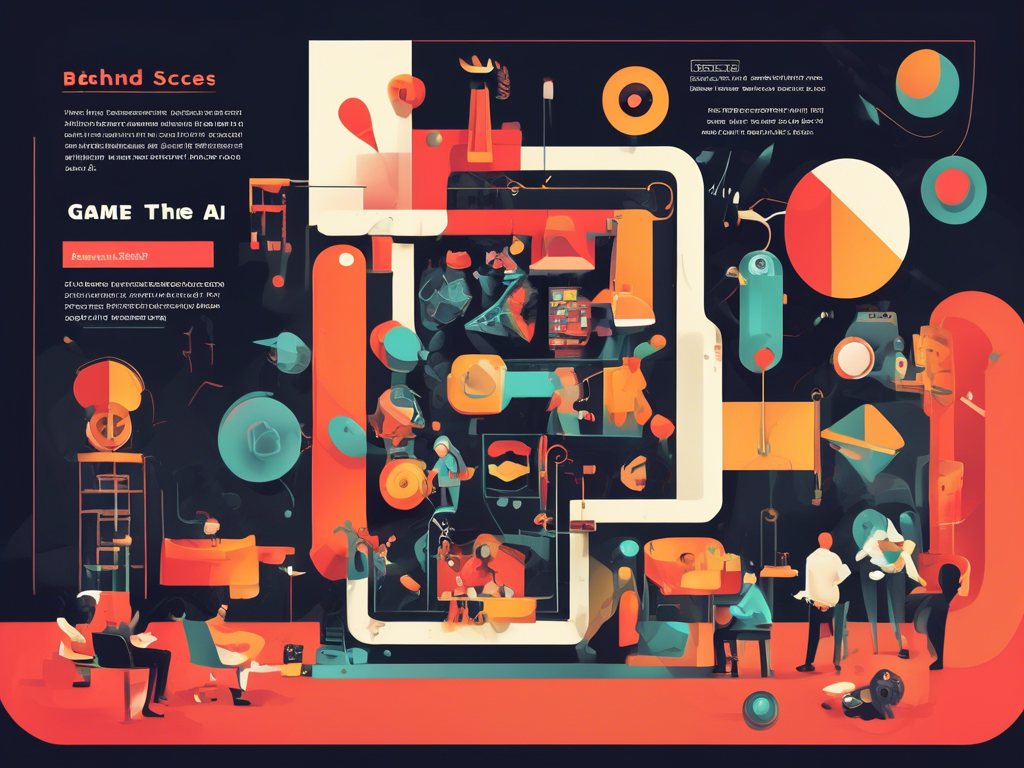In the ever-evolving landscape of technology, the fusion of Artificial Intelligence (AI) with game development and virtual reality is not just an innovation—it’s a revolution. This synergy is reshaping the way we interact with digital worlds, making the experience more immersive, intuitive, and engaging than ever before. The transformative role of AI extends far beyond mere enhancements in graphics or gameplay; it is now a pivotal element in creating complex, adaptive environments that respond to and learn from player behaviors.
The integration of AI in Virtual Reality (VR) takes immersion to unprecedented levels, allowing for smarter virtual experiences that can anticipate user needs and preferences. As we take a deep dive into this technological matrimony, we uncover how AI algorithms empower VR environments to become more realistic and responsive, thus delivering a richer, more authentic experience.
As we stand on the cusp of what could be a seismic shift in the gaming industry, we explore the future of gaming and how AI is not just shaping new virtual worlds but redefining the very notion of interactive entertainment. From enhancing immersive experiences for gamers to impacting game design and player engagement behind the scenes, AI’s footprint on this domain is indelible and far-reaching.
Through this article, we aim to dissect the multifaceted impact of AI on both game development and virtual reality, setting the scene for a discussion that is as intriguing as it is important for the future of digital media.
AI in Game Development and Virtual Reality

Exploring the Synergy: AI’s Transformative Role in Game Development
The advent of Artificial Intelligence (AI) has ushered in a new era for game development, blending creativity with computational power like never before. As developers dive deeper into the realm of AI, they are discovering not just improvements in efficiency but also groundbreaking opportunities to enhance storytelling, gameplay, and player engagement. The transformative role of AI in game development is evident through its application in creating more dynamic game environments, realistic NPCs (Non-Player Characters), and sophisticated game mechanics that react to player choices in real-time.
Leveraging AI technologies, game developers can now craft experiences that adapt to the player, offering a unique journey for every individual. This level of personalization was previously unimaginable and is only possible through the strategic use of AI. Moreover, AI-driven analytics provide insights into player behavior, helping developers fine-tune game elements to meet player expectations better and create more engaging content.
The Impact of AI on Creativity and Efficiency in Game Design
The impact of AI on creativity and efficiency in game design cannot be overstated. By automating certain aspects of the development process, such as asset creation and testing, AI allows developers to focus on the more creative aspects of game creation. This automation results in faster development cycles, enabling games to reach the market more quickly while maintaining high-quality standards.
Furthermore, AI plays a crucial role in enhancing the creative dimensions of games. For example, procedural content generation, powered by AI, enables the creation of vast, complex worlds with minimal human input. This not only makes the game development process more efficient but also opens up new possibilities for game narratives and environments, pushing the boundaries of what games can achieve.
The synergy between AI and game development is transforming the industry, leading to more immersive and personalized gaming experiences. As AI technology continues to evolve, its role in game development is set to become even more significant, promising a future where games are not just played but experienced on a whole new level.
Virtual Reality Gets Smarter with AI Integration: A Deep Dive
Enhancing Immersive Experiences Through AI
The integration of Artificial Intelligence (AI) into Virtual Reality (VR) is evolving the landscape of immersive experiences, setting a new standard for interactivity and realism. By harnessing the power of AI, VR developers are able to create environments that are not only visually stunning but also intelligent and responsive. This fusion amplifies the immersive nature of VR by making virtual worlds more adaptable and interactive, thus enhancing the user’s sense of presence within these digital realms.
AI algorithms can analyze a user’s behavior and preferences to customize experiences in real-time, ensuring each interaction is tailored to individual users. This level of personalization is transformative, making every VR journey unique and deeply engaging. Furthermore, AI-driven avatars and NPCs become more realistic, capable of exhibiting complex behaviors and interactions that mimic real-life entities closely. This leap in realism and interactivity pushes the boundaries of what VR can achieve, providing users with unparalleled immersive experiences.
Revolutionizing Content Creation and Interaction
One of the most significant impacts of AI integration into VR is on content creation and interaction within these virtual spaces. AI tools and techniques, such as machine learning and procedural generation, are revolutionizing the way VR content is developed. These technologies enable the creation of expansive, dynamic worlds with a depth and variety that were previously unattainable. As a result, developers can craft more complex and engaging narratives, giving users the freedom to explore and interact with the virtual world in ways that constantly surprise and delight.
Moreover, natural language processing (NLP) and gesture recognition powered by AI are making VR interactions more intuitive and human-like. Users can communicate with the virtual environment and its inhabitants in a natural and seamless manner, from conversing with AI-powered characters to manipulating objects in a way that mirrors real-life actions. This advancement not only enhances usability but also deepens the level of immersion, making VR experiences more accessible and enjoyable for a wider audience.
The synergy between AI and VR is forging a future where virtual experiences are not just seen and heard but felt and lived. As AI technologies continue to advance, their integration with VR promises to unlock even more extraordinary possibilities, shaping a new era of immersive entertainment and applications beyond our wildest imaginations.
The Future of Gaming: How AI is Shaping New Virtual Worlds

Creating More Authentic and Dynamic Virtual Worlds
The integration of Artificial Intelligence (AI) into gaming is pioneering the creation of virtual worlds that are more authentic and dynamic than ever before. With advancements in AI technology, developers are equipped to construct environments that respond in real-time to player actions, creating a level of interactivity and realism previously unattainable. This leap forward enables games to offer not just visual or narrative richness, but also an adaptive experience that can evolve based on the players’ decisions, enhancing the depth and replayability of games.
AI’s role in environmental design also extends to the natural evolution of game settings. For example, ecosystems within games can change with time, weather systems can react dynamically to certain in-game events, and NPC behaviors can become more complex, providing players with challenges and interactions that are varied and unpredictable. This complexity and variability ensure that each player’s experience is unique, pushing the boundaries of personalized gaming and immersion in digital worlds.
Advancing Player Interaction with AI Companions and Opponents
A significant aspect of how AI is transforming the future of gaming lies in the development of AI companions and opponents. These entities, powered by sophisticated AI algorithms, are capable of learning from the player’s behavior, leading to more engaging and challenging interactions. AI companions can offer assistance, guidance, and even emotional support, adjusting their behavior based on the game’s context and the player’s needs. On the other hand, AI opponents become more formidable adversaries as they adapt to the player’s strategies, creating a continuously evolving challenge that keeps games exciting and rewarding.
Moreover, the use of Natural Language Processing (NLP) allows for deeper communication between players and these AI characters. Players can interact with them through voice or text in a way that feels natural and intuitive, significantly enhancing the narrative immersion. These interactions contribute to a richer storytelling experience, where players can influence the story’s direction and outcome through their choices and relationships with AI-driven characters.
As AI continues to advance, its integration into gaming is set to redefine player expectations, offering experiences that are increasingly interactive, immersive, and personalized. The future of gaming, shaped by AI, promises not only new forms of entertainment but also new ways of experiencing and interacting with virtual worlds.
AI in VR: Enhancing Immersive Experiences for Gamers
Transforming Player Engagement with Adaptive Environments
The combination of Artificial Intelligence (AI) and Virtual Reality (VR) takes player engagement to new heights by crafting adaptive environments that respond intelligently to user actions. This seamless integration creates a dynamic gaming landscape where every decision and movement can alter the virtual world, making each gaming session unique. Through the use of sophisticated AI algorithms, virtual environments can now evolve in real-time, reflecting changes that align closely with the player’s journey. Whether it’s the alteration of landscapes based on player choices or the dynamic adjustment of game difficulty, AI makes these adaptive experiences possible.
Moreover, the immersion facilitated by VR is significantly amplified by AI’s ability to generate rich, interactive worlds. Players are not merely navigating static settings but are plunged into ever-changing ecosystems that challenge their perceptions and strategies. This dynamic interplay between player action and environmental response results in a deeply engaging and personalized gaming experience, pushing the boundaries of what immersive gaming truly means.
Enhancing Realism through AI-Controlled Characters and Narratives
One of the most groundbreaking aspects of integrating AI in VR technologies is the enhancement of realism through AI-controlled characters and evolving narratives. These characters, powered by advanced AI, exhibit behaviors and emotions that mimic real-life interactions, fostering a deeper connection between the player and the virtual world. AI-driven NPCs can engage in complex conversations, show adaptive responses to player actions, and even develop over time, adding layers of depth to the gaming narrative.
The narrative aspect of games also benefits immensely from AI, as it enables the creation of storylines that adapt to the player’s decisions, creating a truly personalized experience. Instead of following a linear storyline, players can influence the direction and outcome of the game, leading to multiple endings and scenarios based on their choices. This level of narrative flexibility and character realism enriches the VR experience, making players feel like active participants in a living, breathing world rather than mere observers.
As AI and VR technologies continue to evolve, their synergy is set to redefine gaming, offering experiences that are not just played but lived. The promise of fully immersive, adaptive, and realistic virtual worlds is on the horizon, heralding a new era in which gaming experiences are limited only by imagination.
Behind the Scenes: The Impact of AI on Game Design and Player Engagement

Revolutionizing Game Mechanics with Advanced AI Technologies
The integration of Artificial Intelligence (AI) in game design is revolutionizing the way games are played and experienced. By leveraging advanced AI technologies, developers can create game mechanics that are more complex, adaptive, and realistic, leading to higher levels of player engagement and satisfaction. These mechanics include AI-driven systems that dynamically adjust gameplay based on players’ actions, ensuring that no two gaming sessions are alike. For instance, AI can modify game difficulty in real time, creating a seamless experience that keeps players both challenged and intrigued.
Furthermore, AI-enhanced game mechanics can simulate real-world physics and logic, providing a more immersive gaming experience. This allows for more natural interactions within the game environment, such as objects that react believably to player actions and NPCs that exhibit more complex behavior patterns. The depth and realism added by these AI-driven enhancements not only elevate the gameplay experience but also encourage deeper emotional investment from players, making games more engaging and memorable.
Personalization and Adaptive Storytelling: Changing the Narrative Game
One of the most impactful ways AI is changing game design and player engagement is through personalization and adaptive storytelling. AI technologies enable game developers to craft narratives that adapt in real time to players’ decisions, creating a personalized story experience for each individual. This approach to storytelling represents a significant shift from traditional, linear game narratives to dynamic storylines that evolve based on player choices.
By analyzing player behavior and preferences, AI-driven storytelling can adjust plot developments, character interactions, and even dialogue, ensuring that the narrative feels relevant and engaging to each player. This level of customization enhances the player’s emotional connection to the game, as every decision made can significantly influence the narrative outcome, leading to a more immersive and interactive experience.
Moreover, adaptive storytelling opens up new possibilities for game replayability. With narratives that branch in countless directions based on player choices, games can offer fresh experiences and outcomes in subsequent playthroughs, keeping content feeling new and exciting. This innovative use of AI not only enriches the gaming experience but also reinforces player engagement, as individuals are more likely to return to a game where they can discover new storylines and outcomes.
In summary, the impact of AI on game design and player engagement is profound, with technologies revolutionizing game mechanics and storytelling to create more immersive, adaptive, and personalized gaming experiences. As AI continues to advance, its role in enhancing the depth and engagement of video games is expected to grow, offering players truly unique and captivating experiences.
Summing up
In retrospection, the journey through the intricate relationship between AI, game development, and virtual reality reveals a landscape teeming with innovation and possibilities. The transformative effects of AI are not merely supplementary but foundational to creating new gaming experiences that are more dynamic, personalized, and captivating. AI’s integration into VR has paved the way for smarter, more interactive virtual environments that challenge our perceptions of reality and fiction.
As we consider the broader implications of these advances, it is evident that AI-driven technologies are not only revolutionizing the way we play games but also transforming how we perceive and interact with digital content. The potential for further growth and innovation is vast, poised to bring even more remarkable changes to entertainment, education, and various other fields.
This exploration serves as a testament to the boundless creativity and ingenuity that drives the tech and gaming industries forward. As we embrace this wave of change, the article leaves us pondering over the exciting prospects that lie ahead. May this be a clarion call to innovators, developers, and dreamers alike to continue pushing the boundaries of what is possible, thereby ensuring that the virtual worlds of tomorrow are even more vibrant and engaging than we could have ever imagined.
